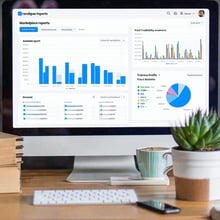Advanced Unit Economics: True Landed Cost & Margin Analysis
Introduction
Many e-commerce sellers think they have a solid grasp on profitability—until they start scaling. As order volume increases, so do hidden costs that eat into margins. The biggest challenge? Understanding true landed cost per unit and conducting a precise margin analysis.
Most sellers rely on broad estimates instead of calculating true landed costs, which include everything from COGS and shipping to customs duties, storage, and return rates. Without accurately tracking these, brands risk overpricing (losing customers) or underpricing (losing profits).
This guide will break down advanced unit economics, how to calculate true landed costs, and strategies to optimize margins so you can scale profitably.
1. What Is True Landed Cost?
Landed cost is the total cost of a product once it has arrived at your fulfillment center or warehouse, factoring in all expenses beyond the manufacturing cost. Many sellers miscalculate this by overlooking smaller—but significant—expenses.
Key Components of Landed Cost:
-
Manufacturing Cost (COGS): Raw materials, labor, factory overhead
-
Packaging Costs: Branded inserts, boxes, protective wrapping
-
Freight & Import Costs: Ocean freight, air shipping, duties, and tariffs
-
Customs & Regulatory Fees: Import taxes and compliance costs (e.g., FDA, CE)
-
Storage & Warehousing: 3PL fees, FBA storage fees, shelf space costs
-
Fulfillment & Last-Mile Delivery: Shipping costs to the customer
-
Return & Refund Costs: Reverse logistics and lost inventory from returns
Formula for True Landed Cost per Unit:
True Landed Cost per Unit = (COGS + Shipping + Customs + Storage + Handling) ÷ Number of Units
Example: If you import 1,000 units with a total shipping cost of $3,000, customs duties of $2,000, and storage fees of $1,500, then your additional landed costs per unit are $6.50 before fulfillment and marketing costs.
2. Why Most Sellers Miscalculate Their Margins
Many sellers assume they have strong profit margins based on simple revenue vs. COGS calculations. However, hidden costs like returns, storage, and advertising can cause real margins to be far lower than expected.
Common Margin Miscalculations:
-
Ignoring Fulfillment Variability: Shipping costs fluctuate based on weight, volume, and zone
-
Overlooking Storage Fees: Long-term storage fees (e.g., FBA) can drastically impact per-unit margins
-
Underestimating Return Rates: Even a 5% return rate can wipe out profits
-
Not Factoring in CAC (Customer Acquisition Cost): High advertising costs shrink margins if not properly tracked
Example: A seller thinks they have a 30% profit margin but, after factoring in returns, long-term storage, and advertising waste, their real margin drops to 10% or lower.
3. Margin Analysis: Understanding Gross vs. Net Profitability
Not all revenue is created equal. To fully understand profitability, sellers need to conduct a margin analysis that differentiates between gross, operating, and net profit.
Key Margin Metrics:
|
Metric |
Definition |
|
Gross Profit Margin |
Measures how much profit is left after production costs |
|
Contribution Margin |
Considers costs like fulfillment, shipping, and marketing |
|
Net Profit Margin |
The final bottom line after all expenses, including operating costs |
Example Analysis:
|
Metric |
Calculation |
Percentage |
|
Gross Profit Margin |
(Revenue - COGS) ÷ Revenue |
50% |
|
Contribution Margin |
(Revenue - Variable Costs) ÷ Revenue |
35% |
|
Net Profit Margin |
(Revenue - All Expenses) ÷ Revenue |
10% |
As seen above, while gross profit looks healthy, once all real costs are accounted for, net margins shrink significantly.
4. How to Optimize True Landed Cost and Increase Profitability
1. Reduce Shipping & Fulfillment Costs
- Use multiple fulfillment centers to lower last-mile delivery fees
- Negotiate 3PL and carrier rates for bulk discounts
- Implement Skupreme's automated fulfillment routing to select the lowest-cost warehouse
2. Improve Inventory & Storage Management
- Reduce long-term storage fees by optimizing stock levels
- Use dynamic inventory distribution to lower warehousing costs
- Use Skupreme's inventory tracking to prevent overstocking and dead stock
3. Control Return Costs
- Improve product descriptions to reduce return rates
- Use automated return tracking to monitor trends and minimize losses
- Offer store credits instead of full refunds when possible
4. Track CAC & Advertising Efficiency
- Monitor ROAS (Return on Ad Spend) to ensure ads remain profitable
- Shift focus to organic traffic and retention marketing (email/SMS)
- Use Skupreme's real-time profitability insights to adjust ad spend dynamically
5. How Skupreme Helps Sellers Optimize Unit Economics
Tracking true landed costs and margin analysis manually is nearly impossible—especially for sellers operating across multiple marketplaces. Skupreme automates profitability tracking by:
- Providing real-time landed cost breakdowns per SKU
- Syncing inventory, fulfillment, and financial data across multiple warehouses
- Identifying high-cost SKUs and recommending fulfillment optimizations
- Tracking return rates, ad spend, and storage fees to uncover hidden costs
With Skupreme's profit-tracking tools, sellers gain accurate, real-time insights to improve margins and scale with confidence.
Final Thoughts: Next Steps for Sellers
- Book a Demo with Skupreme to automate profitability tracking and fulfillment cost optimization
- Follow this blog series to master advanced unit economics and scale profitably
Understanding true landed costs and margin analysis is crucial for maximizing profits and scaling sustainably. By tracking every cost component, optimizing fulfillment, and automating financial insights, sellers can ensure long-term profitability in a competitive e-commerce landscape.
Coming next in our series: "Scaling Profitably: How to Maintain Strong Margins During Rapid Growth"
Learn proven strategies to ensure profitability doesn't suffer as your business expands.



Add Your Comment